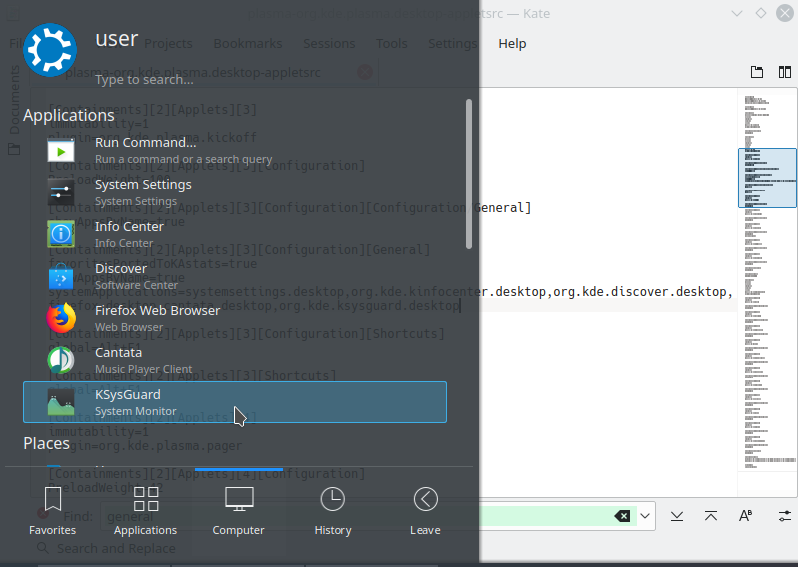!linux@programming.dev could use more folks!
Notepad++ FTW
Sublime Text for me. It has some nifty features that NP++ doesn’t, and looks better out of the box.
How about jottr? https://github.com/mfat/jottr
Every PC I’ve ever owned has had some version of vi installed on it pretty much on day one of my owning it.
So, turns out that they final push that convinced me to start learning Linux is the ol’ Text Document.txt of all things. Swear to God, I thought that it would be the automatic updates nuking my unsaved work (again), but here we are…
Fuck Ai. I just want Notepad to edit the most basic text. Why the fuck would I need fucking Ai bullshit in it? To rewrite what? INI game files? Hosts file?
Fine. Notepad++ is better anyway
It’s a lot more feature filled and frankly not very nice looking if all you want is a simple replacement for Notepad. Notepads (with an s) is much better imo.
Is it though? I still always open notepad for random text stuff. What is better in ++?
Notepad++ isn’t trying to shoehorn in AI for starters. It’s clear Microsoft is praying the current gimmicky narrative of AI will let the masses not realize this is a privacy nightmare.
Notepad does that neither for me and has not for >20 years. So is there something that is actually better or not?
- Keeps your progress if you exit without saving
- Supports tabs so you don’t have 5 separate notepad windows open
- syntax highlighting for programming languages and markdown format
- plugin support
- can handle extremely large text files (I’ve opened 50gb text files and used ctrl+f to find terms and it worked fine)
- superb tools for manipulating text (e.g., use reg expressions). Super easy and flexible in making mass edits.
- dark mode support. That alone makes it superior lol
A lot of those are features of notepad.
Specifically: tabs, dark mode, and retention of unsaved documents. They’re apps for very different purposes, but Notepad has had some nice little updates over recent years.
Ah thanks for the first proper answer. Sounds good, I will give it a try.
+10000 for notepad++, its he swiss army knife of file editing tools. Adding:
-
Plugins: CSV being read as a small dB table you can query is a game changer. Or have a JSON plugin that auto formats and queries as well as opens the JSON in a clickable nested window.
-
Pinned tabs: pin important tabs, I use one as a todo list.
-
Search for text within files in a folder: need to find a specific bit of text in one of dozens/hundreds/thousands/millions of files somewhere? Its lightning fast and works a treat
-
Search and replace with regex: amazing feature, use regex patterns to find complex parts of your files and replace them with something else Bulk operations: remove newline, replace line breaks etc
-
Multi format support: see line breaks from different OSs like Unix and windows and amend them Portable install: you dont have to install it, you can use a portable version
So much more, get it and you won’t look back.
-
Just to point out that on Win11, Notepad also:
- Keeps progress without saving
- Supports tabs
I use a bunch of text editors / note taking apps regularly (or semi-regularly) and Notepad is one of them (among others also Notepad++, VSC, Obsidian, Geany, Notion…).
Your first two points are part of Notepad now too. Everything else you’ve said is true though, including the find and replace function supporting regex. It’s amazingly powerful for editing.
It also supports line numbering, which seems like a small thing but is really helpful.
A few of those features are available on Notepad as well, just FYI.
Ahh interesting. Is that a Windows 11 thing? I haven’t taken the plunge
Out if curiosity, which ones? Because I don’t see any of those features and am on W11…
On my W11 work machine I got dark mode, saving unsaved drafts and tabs
the only thing I need it for is to select text vertically (by holding left alt). there are a few similar ones for linux but some crash and the rest don’t have a dark theme, so I still use it with wine.
Holy moly, that works? I needed precisely that feature earlier! Nice.
Yes, it objectively is. And so are various other text editor options that are out there.
But just speaking about Notepad++, you can scale it down to a very simple text editor (like Notepad), it you can easily ramp it up to a much more feature rich one. And for me, the ability to have a vertical list of files is a big plus. As is its ability to optionally show line numbers.
So it is better because it can do more, but I assume not too too much? Because then we can also use word?
They have different use cases. Notepad++ is for manipulating text, strings, and code. It’s got very powerful tools for it.
Word is for making things look pretty. You can change typefaces, fonts, size. You can add pictures and diagrams and arrange them on the page.
I prefer Sublime
Notepad++ is my text editor of choice as someone who just edits the occasional file. I’m not a programmer or anything, but it’s nice to have those autocomplete and syntax highlighting features for config files. Helps me keep track of stuff better when editing.
Sublime can do all of that as well, but it’s more performant, has better shortcut keys, and IMO it has much nicer navigation for larger files (gives you a sort of eagle-eye’s view of the entire document next to the scrollbar). That’s all very much a personal preference thing of course.
the news is more that they are trying to shoehorn AI in effing Notepad to make sure even those little snippets of text can be used for training
The title is quite sensational compared to the content. They only added an AI Rewrite feature for notepad that requires a Microsoft 365 subscription. Considering the cost of AI, and the fact that it will very probably run in the cloud, it is very reasonable that it isn’t free. Everything else about notepad remains free / included with the price you paid for the OS.
They give Copilot out for free so it’s weird that they’re charging for the Notepad AI feature.
Hell, just copy and paste the content into Copilot and ask it to rewrite it, I bet it’ll just be doing the same thing but for free.
I agree, but the idea of adding AI to notepad is quite insane in its own right
Why? I mean, one of the main features of generative AI systems is to generate text (the quality of which I won’t get into), why not add this to something like Notepad. I agree that Notepad should be thought of as a lightweight, well, notepad, but still might be useful as a quicker alternative to Word.
The fact that Microsoft is trying to shove Copilot down our throats at every possible step is idiotic, I agree, but having an AI as part of a notes app doesn’t seem too weird.
Adding layers to paint was what surprised me
That’s actually very nice, one of the few Microsoft programs that I genuinely miss - layers are a quality of life feature that is actually really nice to have 👍
I think the idea is that you can use it for reformatting small sets of data I guess.
“make all the dates in this CSV iso-8601”
“make all the dates in this CSV iso-8601”
This is a use of AI/LLM processing that I could agree with, if it could be trusted. Since it cannot, better to open in vim and regex replace, or process with Python.
That said, I’d rather store as epoch and display as ISO-8601 as the arithmetic is much less prone to error in epoch than any other format.
Yeah look I’m not an AI advocate at all. If I were confronted with this my first instinct would be to manipulate it in a spreadsheet because they can juggle data types like this pretty effortlessly.
The CSV / dates thing was just an example, but I still think it’s a good one. My assistant at work would 100% use notepad like this rather than using a spreadsheet.
It’s also worth pointing out that notepad + LLM would be a lot more flexible than a spreadsheet. Just paste whatever there and explain what you want in plain english. You don’t need to parse your request into regex or spreadsheet formulas. For you and I, we might have spent years interacting with regex and other things such that it’s a pleasant challenge when it arises. For 20 year old me it would have been a tedious impediment to whatever I was trying to achieve.
Genuinely very useful, however I feel that can be achieved without a login and paid AI subscription.
You’re right of course.
Like the other commenter said for this specific problem you’d use a spreadsheet.
It’s just an example though and there are others, like maybe removing url encoding from a string or something.
Again this can be done in some other tool without much fuss, but the versatility offered by notepad will be useful for a lot of people.
Heck, it probably can be done with a regex. (Yeah, I know)
There’s no need to kill three forests just to do the exact same work you could have done by opening your dataset in Excel.
The fact that they choose to mess with Notepad is more telling than the value it has given the alternatives.
Notepad is not free! Bah ha ha ha. Anyway, tons of options out there for those not to lazy to look.
[obligatory linux boast] I really prefer Kate to Notepad because KDE makes superior, non AI encrusted software that actually works for it’s users. And it’s FREE!
I like Kate as a program but man KDE need to change how some of their app names appear in Plasma.
A new user looking through their start menu and seeing “Kate” will have no idea it’s a text editor/notepad. The same is true for multiple other programs.
There is actually an option to do that iirc. You can have it show entry descriptions.

Indeed. That’s what I do on my Plasma system, it’s a good option.
But a new user or someone who isn’t technical won’t see that, they don’t go digging through settings in each app, they just use the defaults.
I guess a solid compromise would be to enable this by default, and anybody who doesn’t like that short descriptor can disable it.
But IMO nothing will beat the no-nonsense straightforwardness of calling OS apps immediately intuitive names. This is something I believe Gnome gets right. Go onto their GitHub and their file manager is called Nautilus, but on your system it will default to being called “Files”, because they know everyone will understand what “Files” is but a lot of people would ask “Wtf is Nautilus??”, same goes for other apps, e.g. “Loupe” appearing as “Image Viewer”.
What does “Excel” do? What does “Steam” do? What does “Balena” do? What does “Conky” do?
Programs that we think of as being part of the OS, such as the included text editor, is a very different thing to something like Steam.
Steam isn’t preinstalled on your PC, it’s not a core part of your desktop OS. You download Steam yourself, so you only do it once you know what it is.
Third party apps kinda need unique names and branding like that to distinguish themselves.
Besides, even if that weren’t the case, another dev doing it doesn’t mean KDE should.
A newbie won’t know what “Kate” or “Okular” do. They might know what “Dolphin” does because it has a folder as the app icon (although users of screen readers won’t see that). They will probably know what “Notepad” or “Text Editor” does, though.
Kate isn’t a part of the OS, though… the text editor that is a part of the OS is called “vi”.
It literally is. It’s part of the KDE Plasma desktop. It comes preinstalled.
The Vim, nano command line text editors also being there doesn’t mean Kate isn’t an OS app.
Would you say the Dolphin file explorer isn’t an OS/system app on the basis that you can use commands like cd, mv, cp, pwd in terminal? Because I certainly wouldn’t.
It’s part of the KDE Plasma desktop.
KDE is not “The OS”.
Would you say the Dolphin file explorer isn’t an OS/system app
That is correct. Dolphin is not a part of “The OS”. Case in point, you can install Kate, and Dolphin, on FreeBSD. And on Windows.
Having vi is a part of the POSIX specification, therefore, it is a part of the OS.
You’re sounding like one of those people that says “ummm ackshully it’s GNU + Linux, not Linux”
Yes, you can have a desktop without a desktop environment. Well done. Nobody does that in the desktop space. Kate is an OS program.
If you install a distro with KDE, you will have Kate. It’s an OS program.
Case in point, you can install Kate, and Dolphin, on FreeBSD. And on Windows.
Pahahaha, that’s not what defines whether a program is an OS one or not. You can run paint on Linux if you wanted to. Based on your definition, Paint therefore isn’t part of the Windows app suite.
Let’s get back on topic - do you think a normal user will hear “Kate” and think “ah, that must be the text editor!”, do you think they’ll hear “Dolphin” and think “ah, that must be a file manager of some kind!”?
personally i find kate struggles with large files. KWrite is a better analog to notepad IMO
I love Kate.
Me too! So much so that I have sworn to name my first secretary Kate.
thanks!
♥️♥️♥️
Even though it’s typically associated with KDE and Linux, it’s also available on Windows. Good for people who haven’t made up their mind yet. It’s a great text editor with a feature-set similar to other advanced notepads.
I’ll be real though, if I hadn’t jumped ship 3 years ago, I’d be cutting my losses with Windows here.
So… who wants to bet that the new version of Notepad is not constantly scraping anything you type into it and feeding it into the AI, regardless of whether you’re paying for this feature or not?
Case in point: Windows 11 “Light” (LTSC) from Microsoft has the classic and advertisement-free version of Notepad.
Sublime text ftw
Notepad++ on windows is kind of the GOAT IMO.
The search and replace UX is 10 years behind. The sole reason I use sublime text instead
Npp has normal, with special characters and regex, does sublime has something better there?
They said UI, so I don’t think they meant features. But honestly I’ve never been unhappy with their UI, aside from one day with multiple replaces across a few files where the autofill from clipboard kept deleting the expression I wanted to be in there as I navigated through what I needed to do.
But that was fine, anyway, it got through it and I’m just happy with the “apply to all open documents” setting. Saved me at least an hour.
They achtually said UX which is User Experience.
The regex engine was not full featured last time I tried. Done know which implementation they use, but it was lacking basic features like end of line matching (if I remember correctly).
I like how sublime looks. But it is absolutely ridiculous that is has no settings UI and expects you to go and manually edit a json file to change even basic settings. Insane. So that’s a no from me.
Tbf, they already control the os itself. They already have access to all of the keystrokes. Implementing it just in notepad feels like a rube goldbergy way of scraping user data.
Linux
End of conversation.
I think that’s the start of the conversation. Which Desktop Environment?
I want a clean, advanced, well designed desktop and Im okay with redoing my work flow
Use Gnome
Gnome is cool but can it be slightly more Windows?
Use Cosmic (PopOS)
I want lots of customization, advanced features, and a traditional windows desktop metaphor
Use KDE
I want Windows and don’t really care about customization
Use Cinnamon
Dude the Windows 9x look was fucking dope
Use Mate
Im installing this on a potato
Use XFCE
This is always so unfair to XFCE. Sure it is low impact on resources but it is also very flexible and customizable. Most people sleep on how good it can be outside of the low resources need.
IMO:
-
want to show off? i3wm with gaps and rofi for menu launcher. Add it some transparency effects too.
-
want the MacOS style? Gnome. Default on a lot of distros.
-
want something stable? XFCE. Install and forget.
Things preventing me from moving to Linux : video games and Adobe Lightroom.
Most video games work through proton on Steam. Lightroom has a web app you can use instead.
Plus RawTherapee and DarkTable are pretty good, and actually free, Lightroom alternatives to boot.
…my cracked version of Adobe CS6
-
I really like my KDE plasma
Well… it just removes so much toxicity from the outset
Gnome is an opinionated desktop environment and that turns some people off. But it’s bold enough to make some design decisions and have a limited scope. KDE tries to be another Windows alternative.
Of course, you could go with a tiling window manager but my vote goes to Gnome. I’ve had a very smooth experience on Gnome for the last couple years.
Yeah, Gnome is like the Apple of the Linux world. The devs have the same kind of “we know better than you do” mentality towards design. The issue tracker is a lot of “hey the OS won’t let me do [edge-case scenario that an OS should be able to do, but which most users won’t bother with]” followed by the devs going “Gnome isn’t designed to support [edge-case scenario]. Bug report closed.” Like the devs have a very “it’s not a bug; It’s a feature” mentality, and anyone who runs into that bug must be using the OS “wrong”.
we know better than you do” mentality towards design
And I agree with them. I think people should pick whatever desktop environment needs the least amount of customization for their needs. Keep it simple. If Gnome works out of the box, use it. If KDE works out of the box, use it.
This is Gnomes biggest advantage to be honest. They have a singular vision of how they want their product to work and they aren’t concerned with edge uses.
I enjoy elements of so many DEs but I keep coming back to gnome because it’s just so well executed over the others.
Yeah my only complaints with gnome are the lack of system tray and the fact that sticky keys don’t work well
The devs have the same kind of “we know better than you do” mentality towards design
It’s not “we know better than you do”
It’s “we have a vision for the desktop environment”
If you granted the user every little thing they wanted, you don’t become a better piece of software. You end up middle of the road. There are limited resources and by keeping a limited scope and having a clear idea of what you want to accomplish- you can do what you aim to do really well. Instead of being mediocre at a lot of things.
My experience with Gnome- it does 95% of what I need a Desktop Environment to do (and certain things others don’t do very well). Some features like
- Being able to push a button, start typing an application’s name, and push enter to start that application
- Being able to push a button, and immediately see at a glance all of the windows I have open and quickly navigate to them
- Being able to easily set keyboard hotkeys so that I launch applications and can run my own custom scripts with the push of a button
Example- I have a script that I set to “Control+Num Pad 5” that opens up a Gnome folder search dialog. I navigate to a folder and click “Ok” and then 4 terminals open on my left monitor. Three small ones stacked on top of each other on the left, one big one on the right. Basically like a tiling window manager. This script has custom commands that run depending on the directory. If I open a react-native folder, it runs an Android emulator and neovim on the big terminal.
Setting that script to a hotkey is as simple as going to “settings -> keyboard -> shortcuts” and just typing in the path to the script and the hotkey combination
- Being able to easily run scripts on files and directories directly from Nautilus (Gnome’s file manager)
Example- When I right click on a pdf file in Nautilus, I have custom scripts that I can run. One is “splitPdf” which creates a new folder called “split” and then creates n.pdf files where n is the number of pages in that pdf. I also have “compressPdf” which will compress the pdf as much as possible and pops up a notification showing you how much. I have one for .xlsx and .doc files called “printPdf” that converts those to pdf files.
Those scripts can be whatever language you want, they just have to be executable, and you just drag and drop them into a specific folder (
~/.local/share/nautilus/scriptsif I remember correct)Those 4 things I think Gnome does better than any other default desktop environment I’ve ever used and I’ve used a lot over the course of my life. The remainder of the items (the 5% of stuff Gnome can’t do) I have found custom plugins and in one scenario it only took me a couple hours to write my own custom plugin.
MacOS does #2 and #4 well by default (although it’s harder to write scripts with their clunky apple script language whereas with Gnome because you can just use regular old fish or bash scripts). With certain applications (like better-touch-tools or karabiner) you can get similar functionality as Gnome.
Windows with Autohotkey does #3 although you have to again use a clunky language (even clunkier than Apple script)
KDE can do #1 (search/launch apps), but feels slower and less streamlined than Gnome’s immediate overview. It does #2 (window overview) and #3 (keyboard shortcuts), but buries these features under layers of settings and inconsistent menus. For #4 (file manager scripts), Dolphin technically supports actions, but configuring them requires wrestling with clunky .desktop files whereas on Gnome you just use fish or bash or python or javascript or whatever the hell you want and stick it in a directory.
In my opinion, Gnome is miles ahead of KDE and while it’s obviously not as polished as MacOS, it has accomplished so much more with its limited resources than a megacorp like Apple does.
What I love is it gets rid of stuff that’s useless. For example desktop icons. What’s the point of having some directory on your computer that’s somehow different than all the other directories? So that you can clutter up your background?
I 100% agree that desktop icons are an outdated concept and I love that Gnome got rid of them in order to focus on the fundamentals. It’s often not about what you add, but what you take away.
I use Vim, actually
Just use
edif you’re feeling so fancyThere always has to be one…
Same.





















